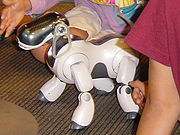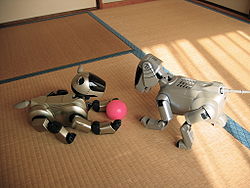AIBO
AIBO (Artificial Intelligence roBOt, homonymous with "pal" in Japanese) was one of several types of robotic pets designed and manufactured by Sony; there have been several different models since their introduction on May 11, 1999. AIBO was discontinued in 2006.
Contents |
Overview
Being able to walk, "see" its environment via camera and recognize spoken commands in Spanish and English; AIBO robotic pets are considered to be autonomous robots since they are able to learn and mature based on external stimuli from their owner or environment, or from other AIBOs. Artist Hajime Sorayama created the initial designs for the AIBO.
The original designs are part of the permanent collections of MOMA and the Smithsonian Institution. The design won Sony and artist Sorayama the highest design award that may be conferred by Japan. On January 26, 2006 Sony announced that it would discontinue AIBO and several other products as of March, 2006 in Sony's effort to make the company more profitable. It will also stop development of the QRIO robot. AIBO will still be supported until 2013 (ERS7 model) and AIBO technology will continue to be developed for use in other consumer products.[1]

AIBOware (the name is a trademark of Sony corporation), is the title given to the software the AIBO runs on its pink Memory Stick. The Life AIBOware allows the robot to be raised from pup to fully grown adult while going through various stages of development as its owner interacts with it. The Explorer AIBOware allows the owner to interact with a fully mature robot able to understand (though not necessarily willing to obey) 100 voice commands. Without the AIBOware, the AIBO will run in what is called "clinic mode" and can only perform basic actions.
Many AIBO owners enjoy teaching their pets new behaviors by reprogramming them (in Sony's special 'R-CODE' language). However, in October 2001, Sony sent a cease-and-desist notice to the webmaster of Aibopet, demanding that he stop distributing code that was retrieved by bypassing the copy protection mechanisms of the robot. Eventually, in the face of many outraged AIBO owners, Sony released a programmer's kit for 'non-commercial' use. The kit has now been expanded into three distinct tools: R-CODE, AIBO Remote Framework, and the OPEN-R SDK. These three tools are combined under the name AIBO Software Development Environment. All of these tools are free to download and can be used for commercial or non-commercial use (Except for the OPEN-R SDK, which is specifically for non-commercial use). Since the first release of OPEN-R, several AIBO programming tools have been developed by university labs, including URBI [2], Tekkotsu [3] and AIBO+[4].
AIBO's complete vision system uses the SIFT algorithm, to recognise its charging station. The newest versions are equipped with a Wi-Fi connection, allowing them to send the pictures they take via email which led to the Roblog.
AIBO's sounds were programmed by Japanese DJ/avant-garde composer Nobukazu Takemura, fusing mechanic and organic concepts. The bodies of the "3x" series (Latte and Macaron, the round-headed AIBOs released in 2001) were designed by visual artist Katsura Moshino.
RoboCup
The AIBO has seen use as an inexpensive platform for artificial intelligence research, because it integrates a computer, vision system, and articulators in a package vastly cheaper than conventional research robots. The RoboCup autonomous soccer competition had a "RoboCup Four-Legged Robot Soccer League" in which numerous institutions from around the world would participate. Competitors would program a team of AIBO robots to play games of autonomous robot soccer against other competing teams. The Four-Legged League ran from 1999 to 2008, although in the final year, many big-name universities did not compete as they had moved to the new NAO platform. The University of New South Wales [5] was the most successful team in the League, making the final six times and winning three times.
International AIBO Convention
The International AIBO Convention takes place every year at Sony Robotics Tower in the Shinjuku prefecture. The first convention took place in 1999, on May 15. It was then set to May 2 to May 4. The 2009 convention, being in its tenth year, set attendance records. The convention usually features AIBO advertisements, free posters, free accessories, freeware/open-source downloads, an acoustic performance from best friends Mark Linn-Baker and Larry Sweeney, and "AIBO Shows".
Breed lineage
After model name: body color choices; release date; units sold.
First generation models

- ERS-110: silver; began sales 1 June 1999 for delivery in August; limited production of 3,000 for Japan and 2,000 for the USA
- ERS-111: grey and black; November 1999; 60,000 (estimated)
Second generation models
- ERS-210: black, silver, gold, red, blue, green, white (3 hues), champagne, etc.; 2001
- ERS-210A: several colors; 2002
- ERS-220: silver; 2002 (also available as a conversion kit for the ERS-210)
- ERS-311 "Latte": cream; 2001
- ERS-311b "Latte": cream; 2002
- ERS-312 "Macaron": black; 2001
- ERS-31L "Pug": brown; 2002
- ERS-210A: cyber blue; 2003
Estimated sales for all second generation models: 60,000
Third Generation models
- ERS-7: white; November 2003
- ERS-7M2: white and black; November 2004
- ERS-7M3: white, black, and champagne brown (called honey brown in Japan); October 2005
Estimated sales for all third generation models: 40,000 to 50,000
See also
- Domestic robot
- i-Cybie, another robotic dog.
- Furby, a robot toy made by Tiger Electronics.
- Sony CISC, which gives telephone technical support for AIBO.
- QRIO, a humanoid robot also developed by Sony
- Asimo, a humanoid robot created by Honda.
- Pleo, robotic dinosaur.
- Nao, a humanoid robot replacing AIBO in Robocup competitions.
- Genibo, a robotic dog from Dasarobot.
- UCHILSIM, a physics based simulator of AIBO robots competing in RoboCup.